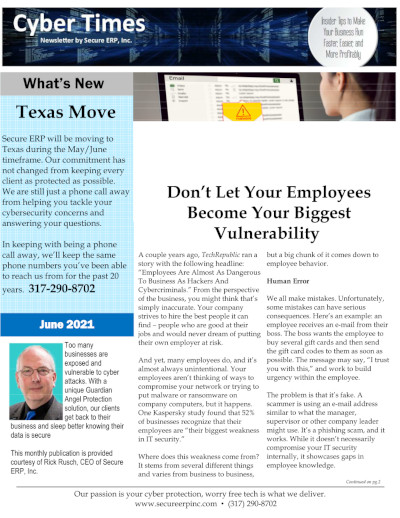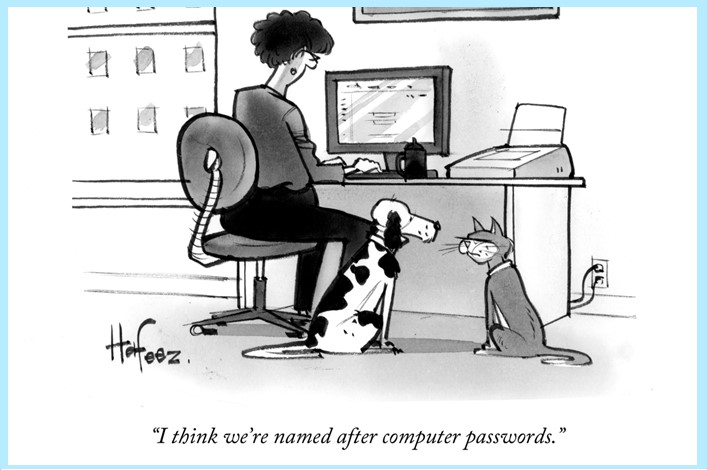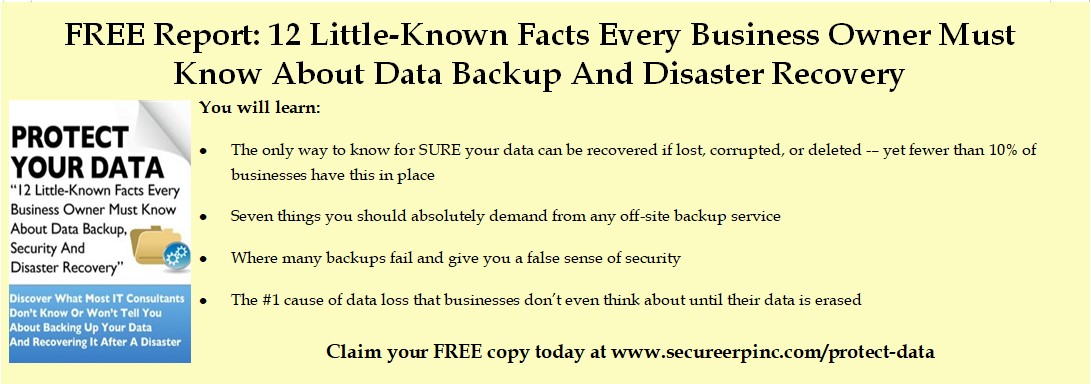
Texas Move
Secure ERP will be moving to Texas during the May/June timeframe. Our commitment has not changed from keeping every client as protected as possible. We are still just a phone call away from helping you tackle your cybersecurity concerns and answering your questions.
In keeping with being a phone call away, we’ll keep the same phone numbers you’ve been able to reach us from for the past 20 years. 317-290-8702
Don’t Let Your Employees Become Your Biggest Vulnerability
 A couple years ago, TechRepublic ran a story with the following headline: “Employees Are Almost As Dangerous To Business As Hackers And Cybercriminals.” From the perspective of the business, you might think that’s simply inaccurate. Your company strives to hire the best people it can find – people who are good at their jobs and would never dream of putting their own employer at risk.
A couple years ago, TechRepublic ran a story with the following headline: “Employees Are Almost As Dangerous To Business As Hackers And Cybercriminals.” From the perspective of the business, you might think that’s simply inaccurate. Your company strives to hire the best people it can find – people who are good at their jobs and would never dream of putting their own employer at risk.
And yet, many employees do, and it’s almost always unintentional. Your employees aren’t thinking of ways to compromise your network or trying to put malware or ransomware on company computers, but it happens. One Kaspersky study found that 52% of businesses recognize that their employees are “their biggest weakness in IT security.”
Where does this weakness come from? It stems from several different things and varies from business to business, but a big chunk of it comes down to employee behavior.
Human Error
We all make mistakes. Unfortunately, some mistakes can have serious consequences. Here’s an example: an employee receives an e-mail from their boss. The boss wants the employee to buy several gift cards and then send the gift card codes to them as soon as possible. The message may say, “I trust you with this,” and work to build urgency within the employee.
The problem is that it’s fake. A scammer is using an e-mail address similar to what the manager, supervisor or other company leader might use. It’s a phishing scam, and it works. While it doesn’t necessarily compromise your IT security internally, it showcases gaps in employee knowledge.
Another common example, also through e-mail, is for cybercriminals to send files or links that install malware on company computers. The criminals once again disguise the e-mail as a legitimate message from someone within the company, a vendor, a bank or another company the employee may be familiar with.
It’s that familiarity that can trip up employees. All criminals have to do is add a sense of urgency, and the employee may click the link without giving more thought.
Carelessness
This happens when an employee clicks a link without thinking. It could be because the employee doesn’t have training to identify fraudulent e-mails or the company might not have a comprehensive IT security policy in place.
Another form of carelessness is unsafe browsing habits. When employees browse the web, whether it’s for research or anything related to their job or for personal use, they should always do so in the safest way possible. Tell employees to avoid navigating to “bad” websites and to not click any link they can’t verify (such as ads).
Bad websites are fairly subjective, but one thing any web user should look for is “https” at the beginning of any web address. The “s” tells you the site is secure. If that “s” is not there, the website lacks proper security. If you input sensitive data into that website, such as your name, e-mail address, contact information or financial information, you cannot verify the security of that information and it may end up in the hands of cybercriminals.
Another example of carelessness is poor password management. It’s common for people to use simple passwords and to use the same passwords across multiple websites. If your employees are doing this, it can put your business at a huge risk. If hackers get ahold of any of those passwords, who knows what they might be able to access. A strict password policy is a must for every business.
Turn Weakness Into Strength
The best way to overcome the human weakness in your IT security is education. An IT security policy is a good start, but it must be enforced and understood. Employees need to know what behaviors are unacceptable, but they also need to be aware of the threats that exist. They need resources they can count on as threats arise so they may be dealt with properly. Working with an MSP or IT services firm may be the answer – they can help you lay the foundation to turn this weakness into a strength.
Cyber Security TIPs
Why a Really Good Backup Should NOT Be Your Only Protection From Ransomware.
I recommend you read an article I found that perfectly describes why companies shouldn’t rely on perfectly good backups to protect them against ransomware attacks.
Here’s the pull quote:
“Restoring encrypted files might seem like the most important thing to do when faced with a ransomware attack. Unfortunately, recovering from backup might just mean recovering systems to a point where the attacker already had access. It doesn’t fix the vulnerabilities that led to the breach. Resolving a ransomware attack isn’t just a matter of the files any more than resolving a flooded basement is just a matter of pumping out the water. You also need to fix the leaky pipes. “ - SC Magazine
But actually read the entire article.
I’ve shrunken the link to usable size: http://bit.ly/backuppanacea
One of the most critical aspects of a malware attack is forensic search to ensure all the doors are locked and the criminal isn’t still in the house.
About half of the businesses successfully attacked by ransomware are out of business in the next 6 months. It’s like a COVID shutdown all over again.
From Start-Ups To Best Places To Work: How Culture Changes Everything
 There are two parts to culture: people and systems. On the people side, consider the “Empathy Accountability Continuum.” Empathy is at one end of the spectrum and accountability at the other.
There are two parts to culture: people and systems. On the people side, consider the “Empathy Accountability Continuum.” Empathy is at one end of the spectrum and accountability at the other.
Then, based on who you are dealing with and the context of the conversation, figure out where you need to be on that continuum.
The more you get to know someone, the easier it becomes to choose the right moment in time to lean toward either empathy or accountability.
How do you know where to land on the scale? Be curious about the people on your team as well as people in the world around you. Ask what they are doing and how they are doing it.
A big part of maintaining curiosity and understanding also comes from being calm and connected. You can’t have a connection with your people unless you are calm. It’s part of being a leader within your organization.
To that effect, you need to be able to lead yourself and know where you are on the Empathy Accountability Continuum. We can’t lead others unless we can lead ourselves. So, we have to understand our own fears and concerns. Then it becomes easier to make those connections.
On the systems side of things, you have to “discover the core”: your core purpose and core values, which tell you what is important to you and your business.
As part of that, you also need to document the future. Plan, strategize and put it into writing. Where are you going? What is your vision? What is your BHAG (big, hairy, audacious goal)? What is your 10-year obsession?
Once you plan and put your future into writing, you have to execute relentlessly. This is how you make sure you get there. Live your system – use daily rituals like huddles and make sure they are useful. You should be constantly talking about your core values and goals.
Of course, as part of building a strong culture, you need a robust recruiting process. Find the right people and keep them engaged. Have a multistep and multiperson process when hiring and use a scorecard (a very detailed job description) when recruiting.
When you bring it all together – people and systems – be sure to show more love. Make sure there is peer recognition and recognition from leadership on a regular basis. Send them cards on their anniversary or birthday. Even have a budget for when bad stuff happens in people’s lives.
But don’t rush your culture. Take it one piece at a time – do something every day to work at it and build something great.
 Tristan White is the founder and CEO of The Physio Co, a unique health care company based in Australia. While he’s led The Physio Co, the company has been ranked one of Australia’s 50 Best Places To Work for 11 consecutive years. In building this fast-growing company, White authored the book Culture Is Everything and started a podcast, Think Big Act Small. Learn more at TristanWhite.com and see his Petra Coach webinar at PetraCoach.com/from-start-up-to-best-places-to-work-how-culture-changes-everything-with-tristan-white
Tristan White is the founder and CEO of The Physio Co, a unique health care company based in Australia. While he’s led The Physio Co, the company has been ranked one of Australia’s 50 Best Places To Work for 11 consecutive years. In building this fast-growing company, White authored the book Culture Is Everything and started a podcast, Think Big Act Small. Learn more at TristanWhite.com and see his Petra Coach webinar at PetraCoach.com/from-start-up-to-best-places-to-work-how-culture-changes-everything-with-tristan-white
Are You Stuck In The Self-Employment Trap?
Many people go the self-employment route in order to have more control over their days, in search of a better work/life balance. But reality soon becomes very different: long hours while you pour everything into the business. This leads to burnout. What actions can you take to avoid or escape this trap?
Delegate More Tasks. This is hard to do, especially when you want things to go just right. Turn your attention to hiring one or more employees who are up to the challenge and can meet your needs. It might take a while to find the ideal match, but it’s worth it to
find someone who can take on crucial tasks and help you achieve your goals.
Inspect Your Systems And Processes. Across the board, you need systems and processes in place. When you have a framework to follow, it makes it much easier to reclaim your time and energy. Inc., Feb. 18, 2021
Make The Most Of Your Remote Workforce
More people are working at home. With a spread-out workforce, businesses face new challenges
that they didn’t face with the traditional in-office model. Now, as businesses adapt, they are looking for waysto get more out of their remote workforce.
- They’re Reorganizing. Businesses are taking a hard look at their internal structure, along with systems and processes. They’re shifting the way they hire by raising their expectations. Along with that, they’re redoing the way they onboard and train. They’re relearning to do everything remotely, and tools like Slack and Zoom are taking center stage.
- They’re Investing In Technology. Businesses are bringing new tools and tech into the mix. They’re investing in communication and collaboration tools. They’re relying heavily on the cloud and VPNs. They’re also buying devices like laptops and PCs for their remote workforce to ensure everyone is using the same, approved technology – which makes support and security more efficient. Inc., Feb. 27, 2021
Use Technology To Make Your Business Stand Out
Today’s workforce is more tech-savvy than ever before. This
means your business should be as well. You want to attract good talent, and leveraging your own tech prowess can be a way to do just that.
Think about how you engage with social media. Is it something that’s just there or is it something you’re using to actively reach out and connect with customers, potential customers and your community? TikTok, for example, relies on a powerful algorithm to reach specific audiences. Businesses can take advantage of that to get content, including ads, to relevant eyes. According to Hootsuite, TikTok pushes for five million daily impressions for certain ads.
Taking it a step further, you can mix AI with human communication. Chatbots are more advanced than ever and can seriously impact lead generation. Chatbots also direct users to real people to continue the conversation on specific terms. Basically, there are more ways to customize how you communicate, and it’s worth investing in. Forbes, March 12, 2021


 Contact Us At
Contact Us At



